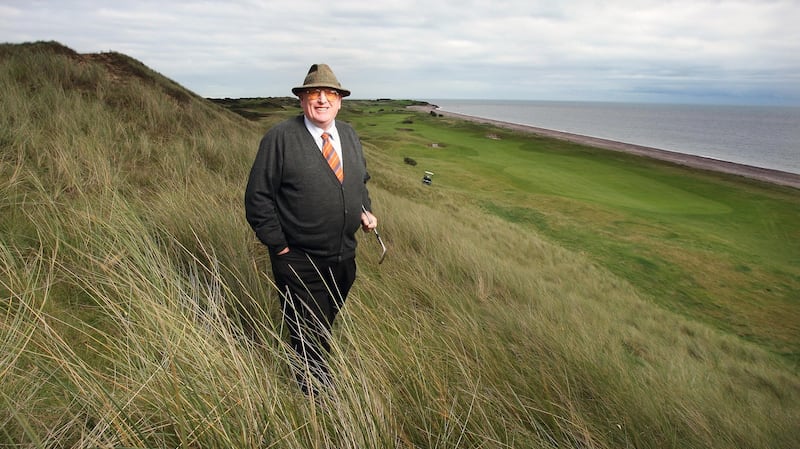Given the way golf is often portrayed as an exclusive, expensive sport played by middle-aged men in pastel trousers and woollen sweaters it might seem odd to say that golf in Ireland is now more accessible and affordable than it has ever been but, in many ways, it is.
Never before has it been possible to play so many quality golf courses for very reasonable prices and you don’t even have to be a member of a golf club to do so. The advent of tee-time booking websites such as GolfNow and TeeTimes.ie has allowed golfers to play as much as they want without having to join a club and without having to fork out huge fees.
A quick check of the Dublin area on GolfNow while this article is being written shows tee times available for this coming Friday at courses such as Luttrellstown, Powerscourt, Carton House, Palmerstown and St Anne’s for less than €50 and that’s at the higher end of the scale. Delve a bit further down and you can enjoy courses such as Lucan, Royal Tara, Black Bush, Rush and Corrstown for less than €20.
At some of those courses you can enjoy a round for as little as €10 every week. Do that 52 times in the year and you’ll spend a total of €520 on golf which, in general, will be at least a few hundred euro less than the club is charging for membership fees. While there undoubtedly are benefits to being a member of a club in terms of playing competitive golf, holding a handicap, the social side of the club and much more, it is striking that so many quality courses are available at such low rates.
So, golf has become cheaper in Ireland but is it becoming too cheap? What is the cost to a club of having large amounts of people out playing the course for very little return? And is there a negative effect for golfers themselves?
With over 400 golf courses in Ireland for a population of 4.5 million, in comparison to around 1,800 in England for a population of 55.5 million, there’s a strong case to be made that there are simply too many golf courses in Ireland.
Those figures equate to roughly one golf course for every 11,250 people in Ireland compared to one for every 33,800 in England. That leads to the regular suburban and countryside courses desperately charging cheaper and cheaper rates as they struggle to survive. Courses are looking for more people coming through the gate in any way possible and that is where underpriced green fees and cheap open competitions come in.
GoflNow currently operates in the majority of Irish golf clubs and it has been both a blessing and a curse for many. The way the system works is that the GolfNow company – which is owned by Comcast who recently purchased Sky – provides golf clubs with the online BRS booking system which most golfers will be familiar with.
That system is provided free of charge in return for one or two green fees per day which GolfNow then sell on their website. Those one or two slots are advertised on GolfNow as ‘hot deals’ and are priced at a cheaper rate than the club’s usual green fee. GolfNow then receives all of the revenue from that ‘hot deal’ tee time.
For instance, this Friday you can book a fourball ‘hot deal’ tee-time in Luttrellstown for €31 per player, meaning GolfNow would receive €124. Outside of that single time slot all of the other green fees available on GolfNow are set at €40 per person, all of which goes to the golf club.
‘Hot deals’
Marcus Doyle is the golf manager at Druids Glen. Both the Glen and Druids Heath courses can be booked on GolfNow and, as Doyle explains, if used correctly it can be of huge benefit to a club.
“We have a deal with GolfNow that they can’t go more than a certain percentage below our rate so if you go online you’re going to see a tee time at 8.20am for €65 but you’re going to see 9.30am or 10am for €75,” he says.
“So for the sake of the extra few euro most will book the later tee time because it’s more convenient (therefore meaning the club will get the revenue from the green fee). In terms of those ‘hot deals’ which we’re offering one of per day, I’d say we’d sell only three of those per week max (meaning only three tee times are bringing no money into the club).”

A benefit of an online booking system is also that customers must pay using their credit or debit card. As Doyle explains, that means that, even in the event of a no-show, the club is still making money and not wasting a tee time, unlike if a customer rings up to book with the intention of paying cash on arrival.
“Year-on-year we’re seeing increases in the amount of online business that’s being done. When I started in 2015, six per cent of revenue was coming in online and that’s now well over 20 per cent and that means fewer phone calls for us to answer, less emails for us to respond to and people can book golf wherever they want in the world with ease through the GolfNow system.
“The average rate of online green fees in Ireland has risen each of the last three years and we’ve seen that here. With that increase in online business there’s been an increase in business in general and that means less demand on the team here which allows us to focus on delivering a first class service.”
Since GolfNow launched in Ireland – it’s also hugely popular in the US and the UK and counts Rory McIlroy and Dustin Johnson among its advertising ambassadors – there have been some worries about the detrimental effect it could have on the industry with clubs giving away green fee slots which they make no money from.
Some worries have been based on what happened to the hotel industry when booking engines such as Expedia and Orbitz came into existence as they offered rooms at cheaper rates, therefore leading to consumers expecting those bargain prices and not paying the rate which the hotel wanted to charge.
A similar trend might be seen in golf if customers are used to paying €15 for a ‘hot deal’ and then may not be prepared to spend the €25 which the course actually charges at regular times, instead just looking elsewhere for another cheap deal.
But while cheaper green fee rates offer golfers the chance to get out and play, for those who want to play competitively there are also ways to do so without breaking the bank. The number of open competitions around the country has risen steadily in the last few years with some clubs now running up to three a week for entrance fees of as little as €10 or €15.
Open competitions
Again this means clubs are getting people on to the golf course but receiving very little return from it while the fact that a player must only play three rounds in their home course per year to maintain a handicap means that many take out cheap long-distance membership simply to get a GUI handicap and then play in open competitions.
Indeed, some clubs have now become so focused on getting as many green fees on the course as possible that it is having a detrimental effect on both the course itself, due to overplay, and the membership.

Members at one Dublin golf club have recently begun occasionally receiving phone calls on a Friday afternoon telling them that their Saturday morning members’ competition tee time is being moved so as to accommodate a society or green fees. In some particularly busy courses in the metropolitan Dublin area the effect of overplay can be seen on greens and tee boxes with huge amounts of pitch marks and divots meaning greenkeepers are forced to sand greens more often, therefore affecting the quality while also putting more work on the course staff.
But while so many suburban and countryside golf courses are engaged in somewhat of a race to the bottom, the green fee market for the top of the range clubs around the country is strong as ever.
For clubs dealing with golf tourists from all over the world, the balance is as much to be struck in charging the guest a substantial fee which fits in with what they’re used to paying. In other words, charge too little and a club is in danger of underselling itself to guests who may make a judgement on the quality of the course based on the price of the green fee.
During the high season next year Royal Portrush, recently the scene of Shane Lowry’s British Open victory, will charge £240 per person for a green fee and slots are booking out fast. Over the course of next summer the club will take in close to £1,000 every 10 minutes or so in green fees and there are many other links courses in the same bracket. For instance this year’s Irish Open host, Lahinch, took in €2.32 million in green fee revenue alone last year.
Pat Ruddy is the owner and founder of the European Club in Brittas Bay and he explains how international visitors are more attuned to paying rates at the very top end. For instance, in comparison to the US, even top level guest fees in Ireland are quite cheap.
At Pebble Beach a round will cost €510, Shadow Creek in Las Vegas charges €450, TPC Sawgrass is €445 while Whistling Straits – host of next year’s Ryder Cup – will cost you €415. The most expensive green fee currently in Ireland is €375 to play Adare Manor so comparatively, for some tourists, forking out €250 to play Portmarnock would seem like good value.
More substantial
“We attracts guests from the whole world – they come to us from Australia, Japan, Argentina, all of North America, all of Europe,” says Ruddy. “The international traveller is attuned to paying a more substantial guest fee. We have a two-tiered system where in winter it’s €120 instead of €225 and in the summer they can play again the next day for €90 so the average comes down to just over €150.
“The €225 is what they call in the hotel area the rack rate or the headline rate. One of the reasons why there’s a gap between the pricing at Irish clubs is that those who interface the world interface the world behaviour. Those who don’t do that face a different market reality. Both are excellent but it depends when you look out the door and see whose coming.
“I campaigned for cheap golf for years. I believe the game should have different levels of courses and different levels of pricing. It’s what the visiting golfers are willing to contribute to the cause because a guest fee in a golf course is basically a contribution to the upkeep of the place you’re going to enjoy.”
Outside of the very top bracket that contribution is becoming less and less and, with the number of active golfers in Ireland now below 200,000 for over 400 courses, something has to give.
– This article is part of a series of consumer-based sports stories. If you have any queries, stories or issues regarding travel, tickets, sport on television or anything else you can email rcroke@irishtimes.com or via Twitter @Ruaidhri_Croke.












